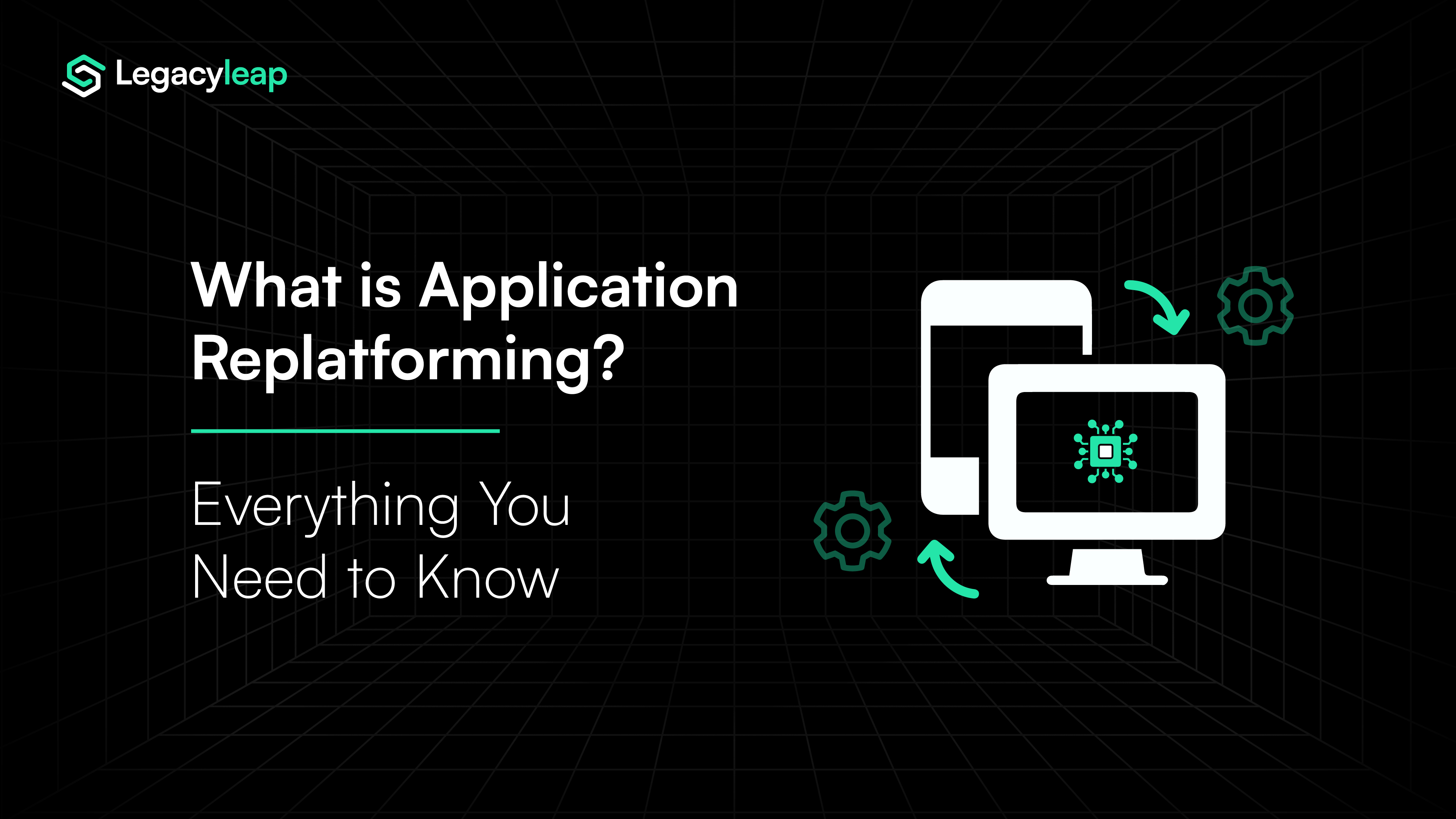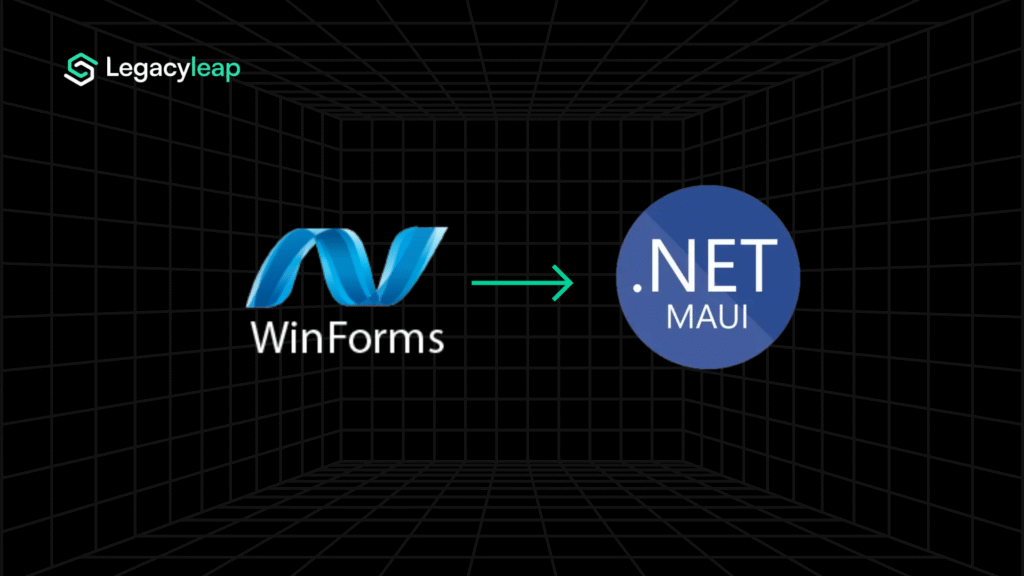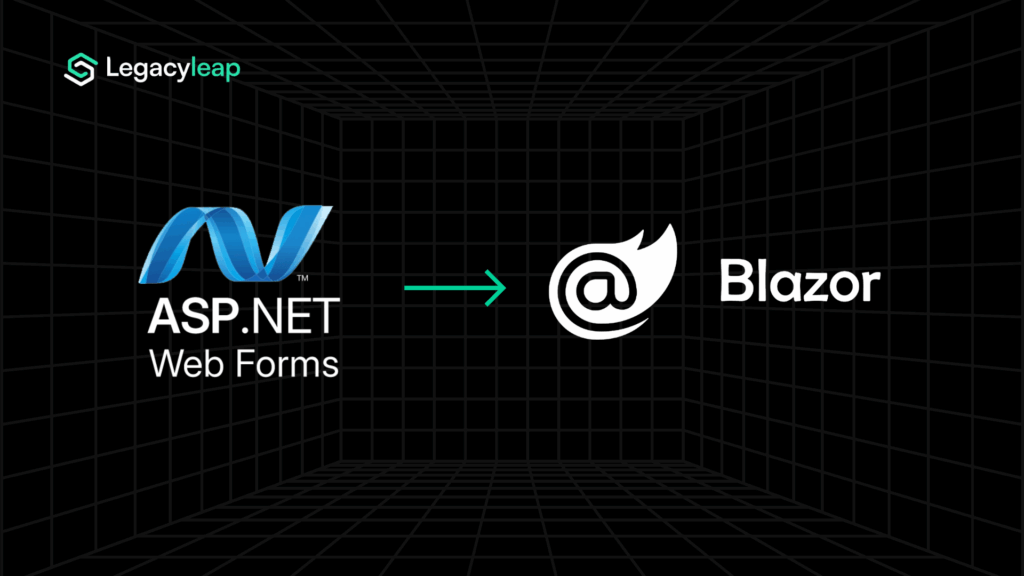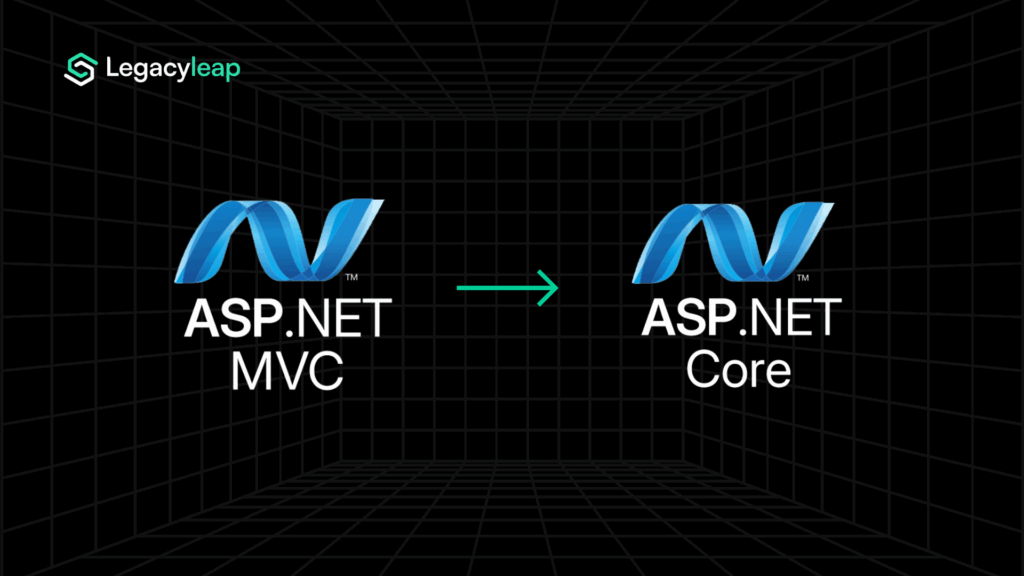Legacy applications can often hold businesses back, creating barriers to innovation and agility. To remain competitive in today’s fast-paced landscape, modernizing these outdated systems is a necessity.
A 2020 IDC study revealed that 52% of enterprise technology still relies on legacy systems, many of which have yet to undergo any form of modernization. This reliance on outdated technology poses significant challenges, from operational inefficiencies to stifled growth and innovation.
Among the many strategies for modernization, application replatforming is one of the most effective methods available. It offers a practical balance of speed and simplicity, enabling organizations to migrate their applications to modern, scalable platforms without the need for a complete system overhaul.
In this blog, we’ll delve into the world of application replatforming—what it is, how it works, when it’s the right fit, the benefits it delivers, and the potential challenges to watch out for. Let’s get started!
What is Application Replatforming?
At its core, application replatforming means taking an existing application and shifting it from one platform to another. But instead of rebuilding it from scratch, you’re optimizing it for a new environment—often to take advantage of cloud infrastructure, modernized hardware, or improved service offerings.
Unlike application rehosting, which simply lifts and shifts applications without changes, replatforming allows tweaking the app to better align with the new platform’s strengths, optimizing for performance, scalability, and cost-efficiency without altering the application’s fundamental architecture.
Speaking of rehosting, here’s where you can learn more about Seamless Application Rehosting In 2025.
Why Consider Replatforming? The Real Business Benefits
The benefits of replatforming are compelling, with several business-critical benefits worth mentioning:
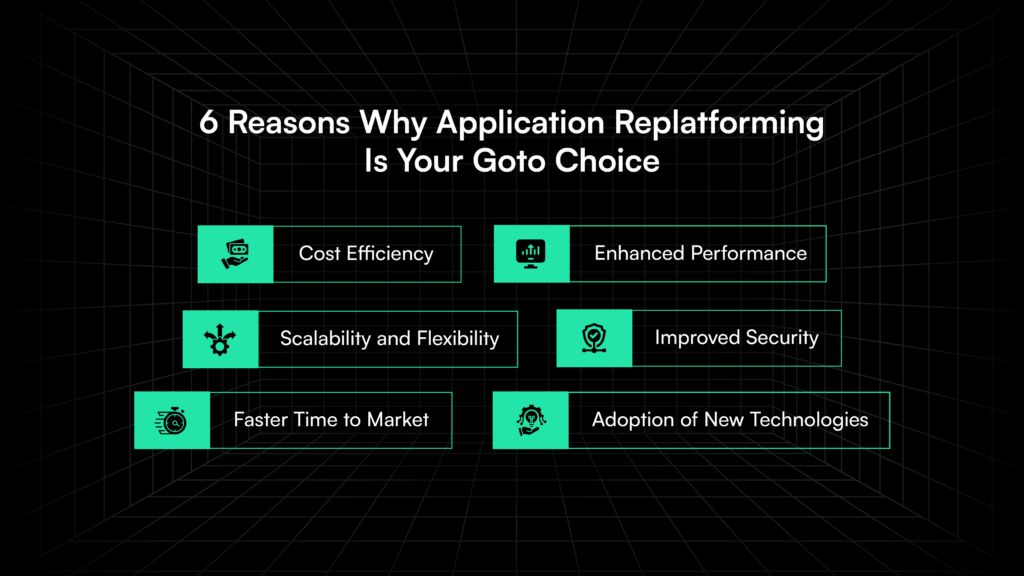
Cost Efficiency
Organizations can reduce operational costs associated with maintenance and infrastructure by optimizing applications for new platforms. This comes from reduced hardware maintenance, lower energy costs, and fewer resources spent on manual updates.
This approach often leads to lower capital expenditures (CAPEX) and operational expenditures (OPEX) by transitioning to a pay-as-you-go model.
Enhanced Performance
Replatformed applications typically exhibit improved speed and reliability. This enhances user experience and reduces maintenance overheads, allowing IT teams to focus on innovation rather than troubleshooting.
Scalability and Flexibility
Cloud environments provide the ability to scale resources up or down based on demand. Replatforming ensures that applications can adapt seamlessly during peak loads without downtime or quieter periods, optimizing resource usage.
Improved Security
Modern cloud platforms often come with advanced security features that can significantly enhance data protection compared to traditional on-premise solutions. This is particularly important as cyber threats continue to evolve.
Faster Time to Market
With replatforming, you can leverage cloud-native tools to innovate faster. Imagine reducing deployment times from weeks to days.
For instance, Netflix’s transition to the cloud allowed them to scale quickly and deliver new features with far more agility, enabling them to maintain their competitive edge.
Adoption of New Technologies
Replatforming makes it easier for your application to integrate with new, cutting-edge technologies. By moving to a more modern platform, you can take advantage of the latest features and innovations that can help improve your app’s performance, security, and overall user experience.
What Does the Replatforming Process Look Like?
While the term “replatforming” might sound like a lot, it’s a really well-defined process that involves the following steps.
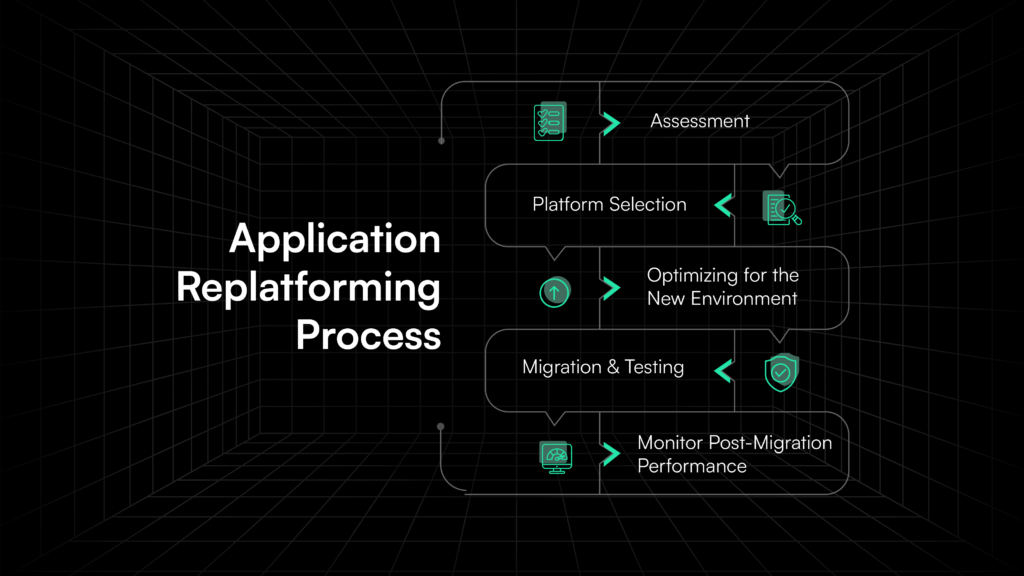
Assessment
Understand the current state of your application. What works well? What needs improvement? Identify which are suitable for replatforming based on performance issues or business needs.
Establish specific goals for what you aim to achieve through replatforming—be it cost savings, improved performance, or enhanced security.
You must also evaluate the performance bottlenecks, technical debt, and areas of inefficiency in the current system. Key components to analyze include:
- Database and storage architecture (e.g., SQL vs NoSQL, legacy storage solutions).
- Compute resources and how they are allocated (on-premises servers vs cloud instances).
- Application dependencies and any third-party integrations.
- Security and compliance requirements for cloud platforms.
This evaluation helps define the technical requirements for the replatforming process and ensures the appropriate cloud infrastructure or platform is selected.
Platform Selection
Choosing the right platform (cloud, hybrid, on-premise, etc.) based on your needs is an important step. Think of this as choosing a new operating system for your app. Making a wrong choice may derail you from your original goal.
Cloud providers such as AWS, Google Cloud, and Azure offer extensive support for various programming languages, frameworks, and deployment methods that should be considered during the selection phase.
Optimizing for the New Environment
This is where the magic happens. To fully take advantage of the new platform’s capabilities, you may need to adjust certain components of your app, such as databases, security protocols, or APIs.
Migration & Testing
Migrate the app, test it, and ensure performance is optimized in the new environment. This is a phased process and not a big-bang move. Start with less critical applications as pilot projects. Use these experiences to refine your approach before tackling more significant workloads.
Gradually decouple legacy components into microservices or separate application layers, migrating one module at a time. Transition databases, often utilizing ETL (Extract, Transform, Load) tools to move data into cloud-native databases with minimal downtime. Initially, some systems may remain on-premises while others are replatformed to the cloud, allowing for a staged transition.
Monitor Post-Migration Performance
After replatforming, continuously monitor application performance and user feedback to ensure that objectives are being met and make adjustments as necessary.
Once the replatforming process is completed, it’s important to optimize the cloud environment. This includes:
- Setting up auto-scaling, load balancing, and cloud monitoring tools (e.g., AWS CloudWatch, Azure Monitor) to ensure performance, availability, and cost efficiency.
- Implementing log aggregation tools (e.g., ELK Stack, Splunk) to track application behavior and identify potential issues.
- Automating security patching and compliance controls via DevSecOps practices to ensure the system remains secure and up-to-date.
Common Pitfalls and Challenges of Application Replatforming
Just like any major tech transformation, replatforming has its own challenges. Here are a few potential pitfalls to watch for:
- Underestimating cost and effort: While cloud services can be more cost-efficient, improper planning can lead to unexpected costs like over-provisioning cloud resources or neglecting long-term maintenance. There’s a risk that initial plans may expand beyond their original intent, leading to increased costs and timelines.
- Improper coordination: A successful replatforming project requires cross-functional collaboration between dev teams, IT ops, security, and compliance. They all need to be on the same page. One of the most common reasons for replatforming projects failing is due to poor coordination.
- Integration complexity: Ensuring that replatformed applications work seamlessly with existing systems can be complex. Organizations must carefully plan integration strategies to avoid disruptions.
The Legacyleap Differentiator
LegacyLeap streamlines application modernization with its CLI and IDE, ensuring smooth transitions to cloud-native technologies.
Unlike basic rehosting, LegacyLeap’s replatforming capabilities fully harness the potential of modern cloud services, maximizing ROI from your modernization efforts.
Key Differentiators:
- UI Deployment: Automates migration and deployment scripts for seamless transitions using AWS S3, CloudFront, and Route 53.
- Resource Computing: Supports migration to serverless technologies like AWS Lambda or Azure App Services and cloud-managed orchestration services like AWS EKS.
- Database Migration: Leverages cloud-managed databases such as AWS RDS and tools like AWS DMS for efficient data migration.
- Automation & Adjustments: Generates Terraform, Helm, and CI/CD scripts while handling minor code changes for effortless cloud compatibility.
LegacyLeap offers an end-to-end solution, enabling you to fully leverage modern cloud technologies for streamlined, efficient application modernization.
Frequently Asked Questions
There are often various concerns companies face when considering application replatforming. Addressing them through careful planning, expert advice, and leveraging the right cloud technologies can help mitigate risks and maximize the benefits of modernizing legacy applications. Here are a few most commonly asked questions and their information.
While the initial costs of replatforming might seem high, the return on investment is often significant. By moving to a cloud-native platform, you gain better scalability, improved resource management, and access to modern technologies like serverless computing, which can result in long-term savings and performance benefits.
Techniques such as blue-green deployment, canary releases, or incremental migration can ensure minimal disruption during the transition. It’s important to plan migration in phases, testing each stage to reduce the risk of downtime.
Using cloud-managed services like AWS RDS or Azure SQL, which offer built-in security features, can help protect your data. Encryption, secure transfer protocols, and ensuring compliance with regulations (such as GDPR or HIPAA) should be part of your migration strategy.
Replatforming is often the start of an ongoing journey. While the initial migration might take effort, maintaining and optimizing the application post-re-platforming is also important. Cloud environments continuously evolve, and applications may need to be updated with new cloud-native features or technologies as they emerge.
If your team lacks cloud expertise, consider partnering with a cloud service provider or a third-party consulting firm experienced in replatforming. You can also provide training to upskill your team in cloud technologies. Cloud platforms like AWS, Azure, and Google Cloud offer extensive documentation, tutorials, and support that can help ease the learning curve.
The right cloud provider depends on your specific needs. Consider factors such as service offerings, pricing, global reach, and compatibility with your current application architecture. AWS, Azure, and Google Cloud all offer extensive support for replatforming, with different strengths in areas like AI integration, compute power, and database services. Evaluate the features that align best with your business needs and existing tech stack.
The Bottom Line: Is Application Replatforming Right for You?
If your goal is to modernize your application while retaining most of its existing structure and minimizing risk, application replatforming is likely the right approach. It balances the need for cloud adoption with the least disruption to your existing operations.
However, you must weigh it against your long-term business goals, team expertise, and the complexity of your current tech stack. If done right, replatforming offers an efficient and scalable way to move into the future.
Why Choose LegacyLeap for Replatforming?
We understand that no two applications are alike. Our approach to replatforming is highly customized, ensuring that we create solutions that fit your specific business requirements. Whether you’re moving to a serverless architecture, containerized environments, or leveraging managed databases, we’ll tailor the migration process to suit your application’s needs.
With Legacyleap, you get:
- Automated Migration Scripts: Save time with pre-built deployment and migration templates.
- Cloud-Native Integration: Maximize scalability, performance, and cost-efficiency.
- End-to-End Support: From code adjustments to deployment, LegacyLeap ensures a hassle-free transition to the cloud.
Take your first step towards a future-proof, cloud-native infrastructure with LegacyLeap’s comprehensive replatforming assessment to gauge where you stand and what’s the right direction you need to head to. Reach out to us to schedule a one-on-one consultation.

